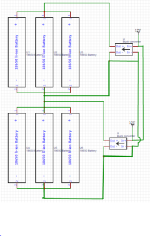ningaman151 said:
The esc has a cuttoff voltage of 42v. That would make packs of less than 16s unable to run with the full discharge range.
That depends on whether you want to kill the cells or not.

Normally the lowest voltage you'd run the cells down to is around 3.0 to 3.2v for the common Li chemistries (other than LiTI and LiFePO4). There's not usually much capacity below that.
If you run down to the spec sheet minimum, especially at a high current, then you can easily overdischarge the cells, especially if they are not well-balanced. Each excursion below the limit damages the cells, so it's cumulative.
Additionally, the cells will unbalance more easily the lower you run them, making the problem more likely to happen again, each time you do it.
So, assumign a 3.0v cell-level lower limit, then the LVC for a 16s pack is 48v.
The LVC for a 14s pack is 42v.
The LVC for a 13s pack is 39v.
So for an LVC of 42v, on a controller listed as compatible with a 48v (13s) pack, it is using a 3.23v per cell lower limit, which is pretty safe.
A BMS, on the ohter hand, often uses a much lower per-cell LVC (as low as 2.8v), because it is a last-ditch line of defense against destroying a pack or starting a fire.
If you always run a pack down until the BMS LVC kicks in and shuts the pack off, it's really really hard on the pack, and it's useful lifespan will be much shorter than if a higher LVC is used.
YOu may "lose out" on 10% (up to 20%) of the total cell capacities...but they will probably last several times as many cycles.
So...specs for individual parts (like cells) aren't necessarily applicable when those parts are part of a system. The specs may have to be derated for actual usage scenarios.
Lots of research and reading still go go.



